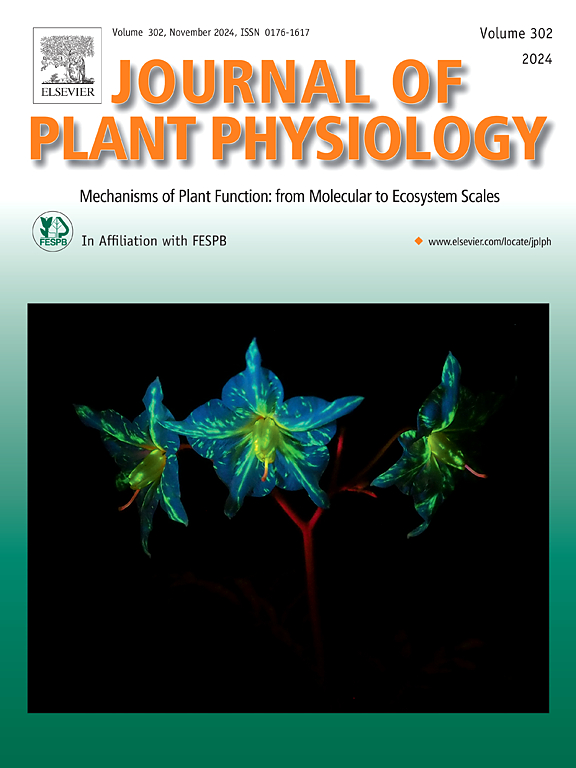通过减少活性氧、自噬和细胞死亡的新型小分子在油菜籽和大麦中促进小孢子胚胎发生
IF 4.1
3区 生物学
Q1 PLANT SCIENCES
引用次数: 0
摘要
在逆境条件下,体外培养的小孢子可以被重新编程为胚胎发生途径,即所谓的小孢子胚胎发生,这是一种快速产生双单倍体植物的生物技术工具。然而,并非所有细胞都能成功地改变其发育,由于施加的应激处理,其中许多细胞发生细胞死亡,这导致该过程的最终产量大大降低。在这项研究中,我们分析了几种以前从未在植物中使用过的新型小分子抗氧化剂在小孢子胚胎发生诱导过程中提高细胞活力的潜力。这些新分子已经在甘蓝型油菜(Brassica napus)和普通油菜(Hordeum vulgare)两种作物中进行了测试,在高温(32°C)和低温(4°C)处理下诱导细胞重编程。利用转录组学和生理学的方法,我们分析了氧化应激和自噬的变化,以及它们在小孢子胚胎发生诱导过程中细胞死亡的参与。结果提供了新的证据,表明在胚胎发生诱导过程中,ROS的产生增加,氧化应激和自噬相关基因的上调,所有这些都有助于提高细胞死亡率。我们发现了新的小分子抗氧化剂,可以减轻这些影响,提高细胞活力,促进小孢子胚胎发生。在两种系统发育较远的作物物种中发现的结果表明细胞反应保守,并突出了这些化合物在其他物种中改善体外方案的潜力,这些物种在胚胎发生诱导过程中早期细胞死亡构成重大挑战。本文章由计算机程序翻译,如有差异,请以英文原文为准。
Enhancing microspore embryogenesis initiation by reducing ROS, autophagy, and cell death with novel small molecules in rapeseed and barley
When submitted to stress conditions, microspores cultured in vitro can be reprogrammed towards an embryogenic pathway, the so-called microspore embryogenesis, which constitutes a biotechnological tool to rapidly produce double-haploid plants for breeding programs. Nevertheless, not all cells succeed in switching their development and, as a consequence of the stress treatment applied, many of them undergo cell death, which causes a significant reduction of the final yield of the process. In this study, we have analyzed the potential of several novel small molecule antioxidants, never used before in plants, to improve cell viability during microspore embryogenesis induction. The new molecules have been tested in two crop species, Brassica napus and Hordeum vulgare, in which cell reprograming was induced by heat (32 °C) and cold (4 °C) treatments. Using transcriptomic and physiological approaches, we have analyzed changes in oxidative stress and autophagy, and their involvement in cell death during microspore embryogenesis induction. The results provide new evidence of increased ROS production and upregulated oxidative stress and autophagy-related genes during embryogenesis induction, all of which contribute to higher cell death. We identified novel small molecule antioxidants that mitigated these effects, enhancing cell viability and promoting microspore embryogenesis initiation. The findings in two phylogenetically distant crop species suggest a conserved cellular response and highlight the potential of these compounds to improve in vitro protocols in other species where early-stage cell death poses a significant challenge during embryogenesis induction.
求助全文
通过发布文献求助,成功后即可免费获取论文全文。
去求助
来源期刊

Journal of plant physiology
生物-植物科学
CiteScore
7.20
自引率
4.70%
发文量
196
审稿时长
32 days
期刊介绍:
The Journal of Plant Physiology is a broad-spectrum journal that welcomes high-quality submissions in all major areas of plant physiology, including plant biochemistry, functional biotechnology, computational and synthetic plant biology, growth and development, photosynthesis and respiration, transport and translocation, plant-microbe interactions, biotic and abiotic stress. Studies are welcome at all levels of integration ranging from molecules and cells to organisms and their environments and are expected to use state-of-the-art methodologies. Pure gene expression studies are not within the focus of our journal. To be considered for publication, papers must significantly contribute to the mechanistic understanding of physiological processes, and not be merely descriptive, or confirmatory of previous results. We encourage the submission of papers that explore the physiology of non-model as well as accepted model species and those that bridge basic and applied research. For instance, studies on agricultural plants that show new physiological mechanisms to improve agricultural efficiency are welcome. Studies performed under uncontrolled situations (e.g. field conditions) not providing mechanistic insight will not be considered for publication.
The Journal of Plant Physiology publishes several types of articles: Original Research Articles, Reviews, Perspectives Articles, and Short Communications. Reviews and Perspectives will be solicited by the Editors; unsolicited reviews are also welcome but only from authors with a strong track record in the field of the review. Original research papers comprise the majority of published contributions.
 求助内容:
求助内容: 应助结果提醒方式:
应助结果提醒方式:


